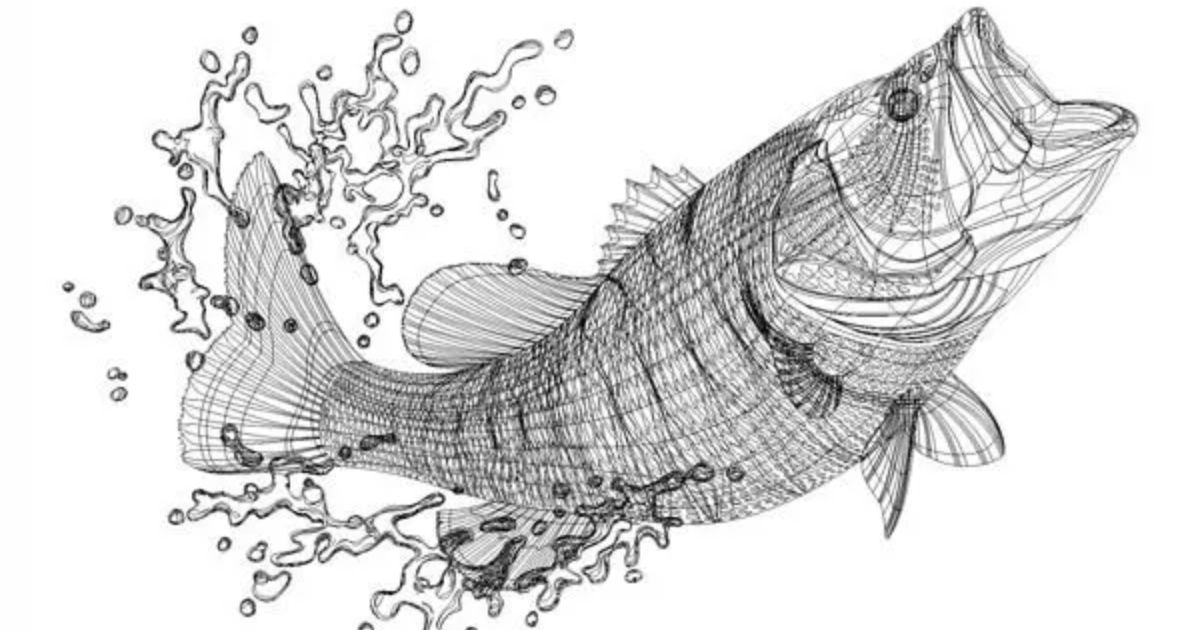Bass fish, with their sleek bodies and distinctive markings, have long been a popular subject for artists and nature enthusiasts alike. Whether you’re an aspiring artist looking to improve your drawing skills or simply interested in capturing the beauty of this aquatic species on paper, this comprehensive guide on How to Draw Bass Fish will help you unlock your artistic potential.
In this blog, we will explore step-by-step instructions, tips, and techniques that will empower you to create lifelike and visually appealing drawings of bass fish. By the end of this guide, you’ll have the knowledge and confidence to bring these magnificent creatures to life on your canvas.
Understanding the Anatomy of Bass Fish
Before we dive into the drawing process, it’s crucial to familiarize ourselves with the fundamental anatomy of bass fish. Understanding their physical characteristics and key features is the first step to creating an accurate and compelling drawing.
Physical Characteristics
Bass fish, also known as largemouth or smallmouth bass, have torpedo-shaped bodies with distinct lateral lines running along their sides. Their dorsal fins are divided into two parts: a spiny front section and a soft-rayed rear section. They are typically found in various colors, with common shades being green, brown, and silver, often adorned with dark horizontal stripes.
The Mouth Bass fish are renowned for their large mouths, extending past their eyes, capable of opening wide to engulf prey.
Gills Located behind their pectoral fins, the gill covers play a vital role in their respiration.
Fins Pay close attention to the dorsal, anal, pectoral, and pelvic fins, each of which has distinct shapes and sizes.
Observing Bass Fish in Their Natural Habitat
To truly capture the essence of a bass fish in your drawing, consider observing them in their natural habitat. Visiting local lakes, rivers, or aquariums allows you to study their movement, the way they interact with light, and their behavior in the wild. These observations will add authenticity and depth to your artwork.
Essential Drawing Supplies
Now that you’re well-acquainted with bass fish anatomy, it’s time to gather the essential drawing supplies needed to embark on your artistic journey. These supplies are the building blocks that will help you bring your bass fish drawing to life.

Pencils and Erasers
Invest in a set of high-quality drawing pencils. These pencils come in various hardness grades, such as 2H, HB, 2B, 4B, and 6B. The range of grades allows you to create different shades and lines, helping you achieve the desired depth and detailing in your drawing. Additionally, having erasers is crucial for correcting mistakes and refining finer details. A kneaded eraser and a precision eraser like a mechanical eraser are valuable tools in your kit.
Sketching Paper
Select the right sketching paper or drawing paper. The choice of paper should align with your chosen medium, whether it’s graphite, colored pencils, or watercolors. Opt for a heavier-weight paper to prevent buckling or tearing, which can be a common issue with lighter paper. A suitable paper texture will also enhance the overall look and feel of your artwork.
Reference Images
Compile a collection of reference images of bass fish. These images will serve as visual aids to ensure the accuracy and authenticity of your representation. You can find these references in books, online resources, or through your own observations. Accurate references are vital for capturing the unique characteristics of bass fish, from their distinctive body shape to the patterns and textures of their scales.
In addition to these essential supplies, it’s also helpful to have a comfortable workspace, good lighting, and a variety of drawing tools, such as blending stumps, tortillons, and a magnifying glass if needed for intricate details. With the right supplies and a passion for capturing the beauty of bass fish, you’re ready to embark on your artistic journey.
Steps to Draw Bass Fish
We’ll provide you with a series of steps to follow in order to draw a detailed and realistic representation of a bass fish. Each step is designed to build upon the previous one, offering you a structured approach to your artistic endeavor.
Start with Basic Shapes and Guidelines
The first step is crucial as it lays the foundation for your bass fish drawing. Starting with basic shapes and guidelines helps you define the fish’s proportions and overall structure. You’ll outline the fish’s body, identify the eye level, mark the mouth’s location, and differentiate the dorsal fin.
Construct the Body
In this step, we focus on refining your initial sketch by adding essential details that construct the fish’s body. Key features like the mouth, gills, pectoral fins, dorsal fin, and anal fin are defined with precision.
Map Out the Fins
Here, we’ll discuss how to map out the pelvic and caudal fins. Ensuring that these fins are well-proportioned and correctly positioned is essential for an accurate representation of the bass fish.
Add Details and Texture
To bring your drawing to life, this step emphasizes the importance of adding intricate details. You’ll learn how to depict the scales, fin rays, and gill covers realistically, focusing on the texture that distinguishes the bass fish.
Shading and Texturing
Shading is a pivotal aspect of creating a three-dimensional effect in your drawing. This step delves into shading techniques, helping you understand how to create the play of light and shadow on the fish’s body. Texturing is equally important, as it contributes to the fish’s lifelike appearance.
Add Highlights and Reflections
Here, you’ll identify the areas where light naturally hits the fish, such as the upper portions of the body and fins. Adding highlights and reflections is essential to create depth and realism in your drawing.
Add Color Optional
For those artists interested in adding color to their artwork, this step explores the use of color pencils or watercolors. It covers selecting an appropriate color palette and applying colors in layers to achieve the desired vibrancy and realism.
Final Touches and Highlights
As you approach the final stages of your drawing, this step is dedicated to making any necessary adjustments. You’ll refine shadows and highlights to ensure your drawing is polished, accurate, and visually appealing.
Framing and Displaying Your Artwork
After you’ve completed your bass fish drawing, it’s essential to understand how to protect and present your artwork. This step provides guidance on selecting the right frame, using acid-free matting for preservation, and choosing UV-protective glass or acrylic to shield your artwork from environmental factors.
Tips for Drawing Realistic Bass Fish
In this concluding section, we offer valuable tips for aspiring artists. Patience and practice are highlighted as essential elements for skill development. Observing live or photographic references is encouraged to enhance your ability to capture realistic details. Experimentation is also encouraged as it allows you to develop your unique artistic style.
FAQs
How do I start drawing a bass fish?
To begin drawing a bass fish, start with basic shapes and guidelines to outline the fish’s body and key features. This provides a foundation for your drawing.
What are some essential supplies for drawing a bass fish?
You’ll need drawing pencils, erasers, sketching paper, and reference images. The choice of medium, like graphite or colored pencils, depends on your preference.
Do I have to use color in my bass fish drawing?
Color is optional. You can choose to create a monochromatic drawing with graphite or explore color options using colored pencils or watercolors for a more vibrant representation.
How can I make my bass fish drawing look realistic?
To make your drawing look realistic, focus on shading, texturing, and adding highlights. Pay attention to the direction of light and practice to improve your skills.
What’s the importance of framing my bass fish artwork?
Framing not only protects your artwork but also enhances its visual appeal. It’s crucial to choose an appropriate frame and use materials that prevent damage over time, such as acid-free matting and UV-protective glass or acrylic.
Conclusion
Drawing bass fish is a gratifying artistic pursuit that allows you to celebrate your creativity and admiration for the natural world. This comprehensive guide has equipped you with the knowledge and techniques necessary to create stunning, lifelike representations of these aquatic marvels.
Remember that practice and patience are key to refining your skills. Each drawing is an opportunity to further develop your talent. So, gather your drawing supplies, follow the steps, and embark on your journey to bring these magnificent creatures to life on paper.

